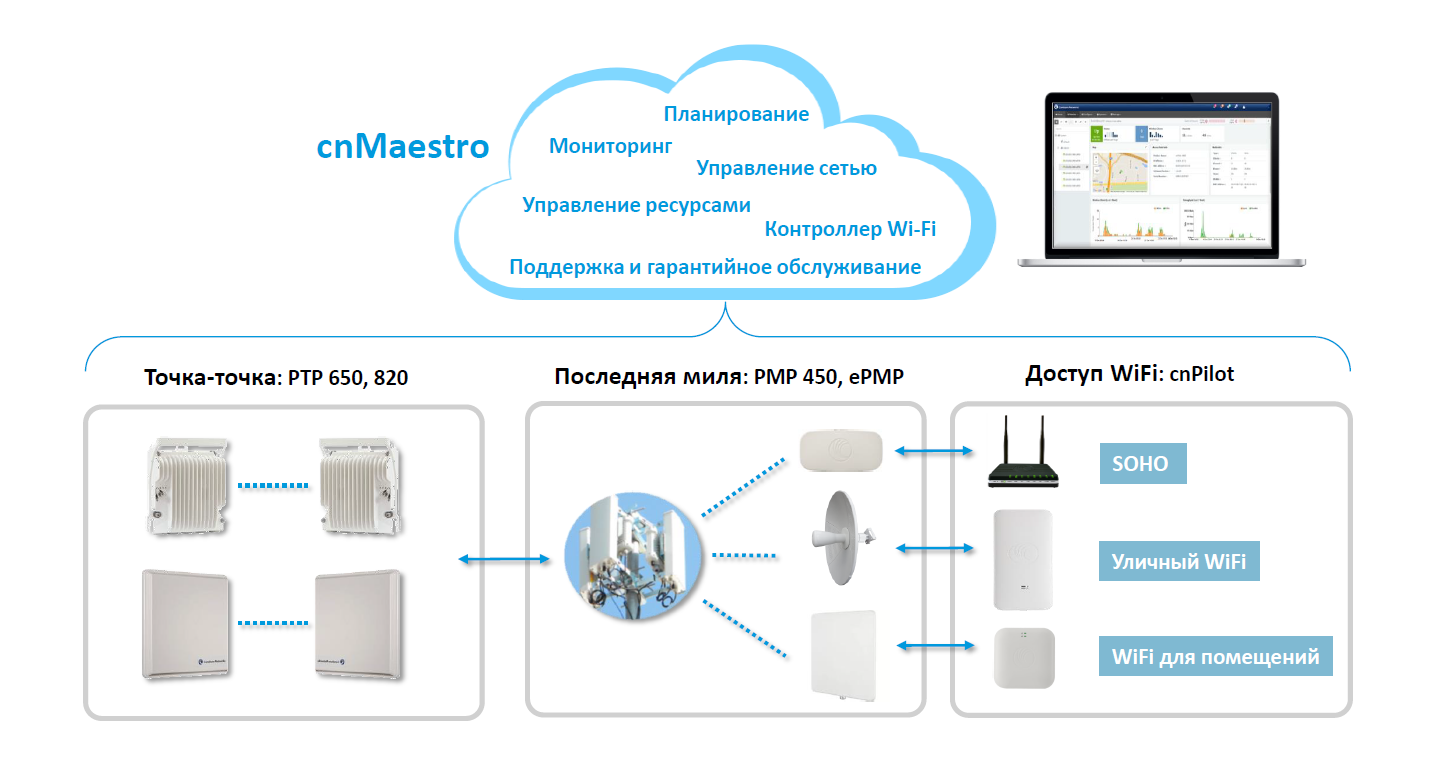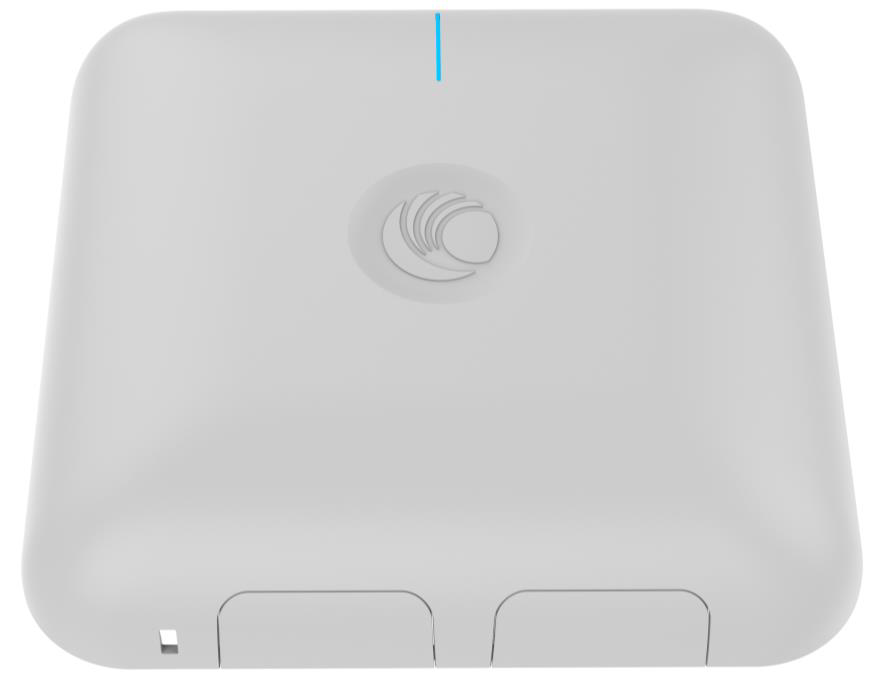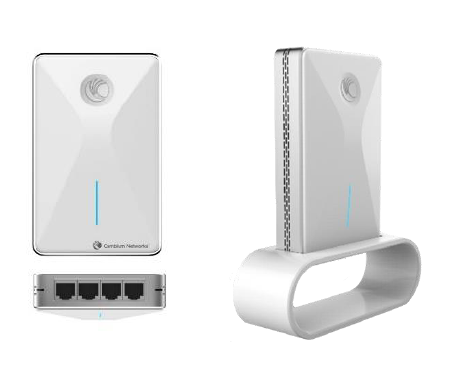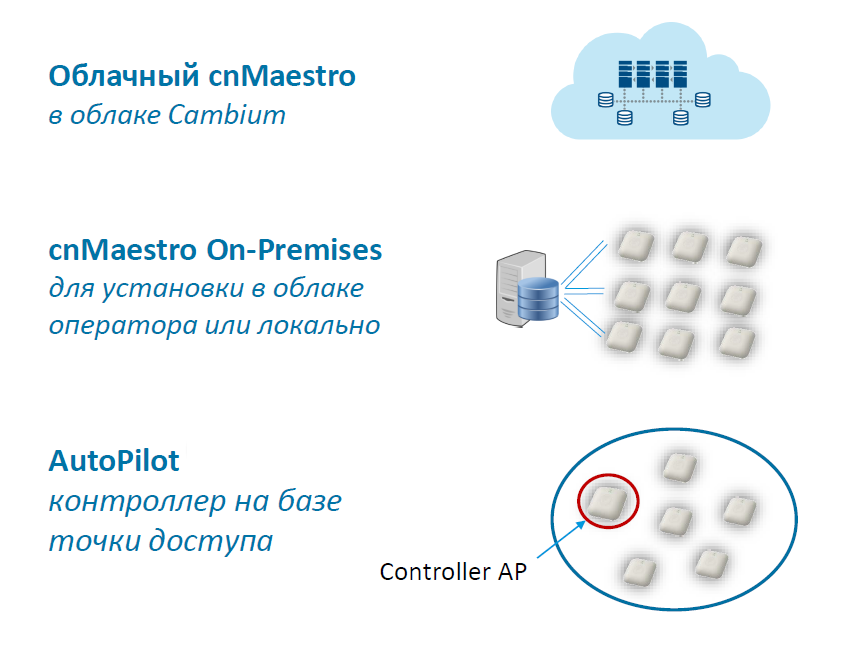The second wave cnPilot
Recently, Cambium Networks ( we have already written about the achievements of this company in the market of wireless technologies) has significantly expanded its product portfolio and functionality of its cnPilot WiFi access platform. About solutions cnPilot 2.0 will be discussed in this material.
Why are we closely watching the development of Wi-Fi products of this particular manufacturer? The approach of the proud successor of the famous Motorola Canopy systems is very attractive: trying to preserve the affordability of products (at a price they are not very different from those of the low-cost mass segment), Cambium Networks strives to provide functionality that is as close as possible to the functionality of first-tier player solutions , Ruckus, aruba).

In fact, on the basis of Cambium Networks products it is possible to build a “wireless factory” with spans from 2 m to 245 km - this is exactly the range that was achieved in a recently implemented project in the mountains. All Cambium Networks products are under the umbrella of the cnMaesto unified management system, which can be deployed in a cloud model and provides end-to-end monitoring of the entire chain of devices.
')
The release of Wi-Fi solutions cnPilot 2.0 marks the appearance of products on the 802.11ac Wave 2 chipset (before this, all the company's products were built on the 802.11ac Wave 1 chipset) with a corresponding extension of the functionality. Recall that the “second wave” 802.11ac implies the possibility of building networks with multi-user (MU) MIMO, the use of 160 MHz channels, the aggregation of non-adjacent channels and a number of other innovations. Among the functions that have appeared in cnPilot products are the possibility of using a controller (autoPilot) built into the TD, an API for analytics and management, detecting unauthorized TDs, receiving graphical reports, etc.
But before we talk more about the functionality, let's see how Cambium Networks product portfolio for corporate and carrier Wi-Fi networks has expanded. (New products appeared for the SOHO segment, but they will not be considered in this material).
Let's start with street access points. TD cnPilot E500 is already well known in Russia. Made in an IP67 package, it works in both bands (2.4 + 5 GHz), supports up to 256 clients and up to 16 SSIDs, and has PoE output. Two modifications with sector antennas are added to this model. The cnPilot E501s model uses an antenna with a 120 degree radiation pattern and a 10 dBi gain for the 2.4 GHz band and 12 dBi for 5 GHz. This model is perfect for covering the site from its corners (which is important, for example, for serving a mass event), as well as for covering from a central point with a cluster of three access points. In this configuration, the manufacturer promised "range" up to 750 m - although, it is clear that the actual range will be determined by the jamming situation at the deployment site. Note that the inverse gain of this AP is 23 dB - a good indicator that gives greater flexibility for the reuse of frequencies in the network.

Installation options street TD cnPilot E501s
Another modification of TD cnPilot E500 - model cnPilot E512s - is equipped with a narrow antenna 30x30 degrees. The gain of this antenna is 12 dBi for the 2.4 GHz band and 17 dBi for 5 GHz. This TD is well suited for building high-density networks, where it is important to implement narrowly targeted service areas.
Note that all TDs of the E500 family are equipped with built-in LTE filters, which allows them to be mounted together with small cellular base stations. No negative impact on the work of Wi-Fi network LTE will not.
As for the indoor TD, a number of models with the Wave 2 chipset built on the base of the 802.11ac Wave 1 model E400 were added. But if the new E410 model supports only a single-user version of MIMO 2x2, the other new product - the E600 - already has a multi-user MIMO 4x4. MU MIMO technology allows simultaneous data transfer to multiple users. In other words, an access point can forward packets to several client devices at the same time and in the same frequency range, which increases overall performance. The MU MIMO mode is especially effective with a high user density.


Compared to the E400 and E410 models, the E600 TD supports twice as many clients - up to 512. It is equipped with two Gigabit Ethernet ports, which, for example, allows you to build a chain of access points. In addition, it supports Bluetooth Low Energy (BLE) technology. This technology can be used, for example, to record the fact that a device is in the “audible” area of an iBeacon tag, as well as to force various messages to be sent to a device next to the device via the Bluetooth channel.

Another novelty in the indoor space TD family is the E430w model. It can be mounted in a bottom plate or mounted on an elegant decorative stand. Among its features is the presence of four Ethernet ports, including those with PoE support, for example, to connect a phone. This TD also supports BLE technology.
Cambium cnPilot Wi-Fi products support a number of algorithms that increase network efficiency in demanding environments:
An important innovation in cnPilot 2.0 is the possibility to use one of the access points as a controller (AutoPilot function). Such a solution, providing support for a network of 32 access points, provides the full functionality of the controller and can be very attractive for small installations.
In addition, there are two options for the implementation of controllers. One of them is the use of the cnMaestro controller in the Cambium cloud. This option has common advantages of cloud solutions: there is no need to keep a staff of administrators, no need to build additional infrastructure, all that is needed is access to the Internet. At the same time, Cambium’s cloud infrastructure, built on Amazon servers, by default has a distributed architecture, a high level of fault tolerance and reliability. The cloudy version of cnMaestro is recommended for those customers who do not want to invest in expensive specialists and their own infrastructure.
The third option is classic - cnMaestro On-Premises. It involves the customer installing the controller software on his server — locally or, for example, in a private cloud. This option ensures the most complete control over the equipment and provides the formation of tunnels (L2TP, GRE) from access points to the controller. The On-Premises option is for those who do not like to give anything to the clouds and / or have a strict security service. Cambium's plans for the development of this option include the release of a software / hardware (rack) controller for 100-150 access points. In addition, a high availability (HA) option is expected: two servers will operate simultaneously in a cluster, if one fails, the other will continue to work.

One of the directions for the development of cnMaestro functional is the expansion of opportunities for service providers. Now the Managed Service Provider Tool allows you to create a tenant account in cnMaestro On-Premises. Such accounts are managed individually or in group mode and have a full set of cnMaestro functions, for example, they allow you to assign roles to users (Root, Administrator, Operator), use dashboards, statistics and other tools. Support for subsidiary accounts may be of interest to Wi-Fi network operators, who have many corporate customers, such as cafes or restaurants, who, in turn, are interested in providing Wi-Fi services to their visitors.
CnMaestro's capabilities for creating various reports have significantly expanded. Previously, the system supported only text reports, as well as their export to third-party applications. Now pre-configured graphical reports have been implemented, in which various indicators are presented with different time details (for the last day, week, month) and geography (by site, network, access point group). In addition, customizable graphic reports are supported. They provide a selection of content, KPIs for benchmarking, and customization (logo, homepage, footers). Customizable reports can be selectively sent to certain employees with the data they need (for example, a boss with generalized information) - the distribution will be carried out automatically to the specified email addresses.
So, the “second wave” of Cambium cnPilot solutions pleases with improved features and new features, while remaining attractive in price. A wider assortment of access points and three variants of the controller’s implementation provide high flexibility in the implementation of projects of different scale at various facilities.
Why are we closely watching the development of Wi-Fi products of this particular manufacturer? The approach of the proud successor of the famous Motorola Canopy systems is very attractive: trying to preserve the affordability of products (at a price they are not very different from those of the low-cost mass segment), Cambium Networks strives to provide functionality that is as close as possible to the functionality of first-tier player solutions , Ruckus, aruba).

In fact, on the basis of Cambium Networks products it is possible to build a “wireless factory” with spans from 2 m to 245 km - this is exactly the range that was achieved in a recently implemented project in the mountains. All Cambium Networks products are under the umbrella of the cnMaesto unified management system, which can be deployed in a cloud model and provides end-to-end monitoring of the entire chain of devices.
')
The release of Wi-Fi solutions cnPilot 2.0 marks the appearance of products on the 802.11ac Wave 2 chipset (before this, all the company's products were built on the 802.11ac Wave 1 chipset) with a corresponding extension of the functionality. Recall that the “second wave” 802.11ac implies the possibility of building networks with multi-user (MU) MIMO, the use of 160 MHz channels, the aggregation of non-adjacent channels and a number of other innovations. Among the functions that have appeared in cnPilot products are the possibility of using a controller (autoPilot) built into the TD, an API for analytics and management, detecting unauthorized TDs, receiving graphical reports, etc.
But before we talk more about the functionality, let's see how Cambium Networks product portfolio for corporate and carrier Wi-Fi networks has expanded. (New products appeared for the SOHO segment, but they will not be considered in this material).
Let's start with street access points. TD cnPilot E500 is already well known in Russia. Made in an IP67 package, it works in both bands (2.4 + 5 GHz), supports up to 256 clients and up to 16 SSIDs, and has PoE output. Two modifications with sector antennas are added to this model. The cnPilot E501s model uses an antenna with a 120 degree radiation pattern and a 10 dBi gain for the 2.4 GHz band and 12 dBi for 5 GHz. This model is perfect for covering the site from its corners (which is important, for example, for serving a mass event), as well as for covering from a central point with a cluster of three access points. In this configuration, the manufacturer promised "range" up to 750 m - although, it is clear that the actual range will be determined by the jamming situation at the deployment site. Note that the inverse gain of this AP is 23 dB - a good indicator that gives greater flexibility for the reuse of frequencies in the network.

Installation options street TD cnPilot E501s
Another modification of TD cnPilot E500 - model cnPilot E512s - is equipped with a narrow antenna 30x30 degrees. The gain of this antenna is 12 dBi for the 2.4 GHz band and 17 dBi for 5 GHz. This TD is well suited for building high-density networks, where it is important to implement narrowly targeted service areas.
Note that all TDs of the E500 family are equipped with built-in LTE filters, which allows them to be mounted together with small cellular base stations. No negative impact on the work of Wi-Fi network LTE will not.
As for the indoor TD, a number of models with the Wave 2 chipset built on the base of the 802.11ac Wave 1 model E400 were added. But if the new E410 model supports only a single-user version of MIMO 2x2, the other new product - the E600 - already has a multi-user MIMO 4x4. MU MIMO technology allows simultaneous data transfer to multiple users. In other words, an access point can forward packets to several client devices at the same time and in the same frequency range, which increases overall performance. The MU MIMO mode is especially effective with a high user density.


Compared to the E400 and E410 models, the E600 TD supports twice as many clients - up to 512. It is equipped with two Gigabit Ethernet ports, which, for example, allows you to build a chain of access points. In addition, it supports Bluetooth Low Energy (BLE) technology. This technology can be used, for example, to record the fact that a device is in the “audible” area of an iBeacon tag, as well as to force various messages to be sent to a device next to the device via the Bluetooth channel.

Another novelty in the indoor space TD family is the E430w model. It can be mounted in a bottom plate or mounted on an elegant decorative stand. Among its features is the presence of four Ethernet ports, including those with PoE support, for example, to connect a phone. This TD also supports BLE technology.
Cambium cnPilot Wi-Fi products support a number of algorithms that increase network efficiency in demanding environments:
- Band Steering allows you to choose your preferred band (2, 4 or 5 GHz) for working with a specific end device, optimally redistributing clients between the usually noisy 2.4 GHz band and the looser 5 GHz band.
- Dynamic Channel Selection provides the choice of the least noisy frequency channel - in a changing environment, cnPilot constantly measures the level of interference and dynamically changes the channel, optimizing performance.
- Air-Time Fairness optimizes collaboration with legacy clients that transfer data at low speeds (for example, 802.11b clients). The client works at a lower speed, the longer it takes to air, which leads to a degradation of the overall bandwidth of the sector. To prevent this from happening, the Air-Time Fairness algorithm limits such clients to their time of ownership of the transmission medium.
- Dynamic Power Adjustment provides consistent output power for optimized coverage. For example, if one of the access points for some reason or other has stopped its work, its neighbors can raise the power level by closing the hole in the cover. Or, on the contrary, if necessary, they can reduce power so as not to interfere with each other.
An important innovation in cnPilot 2.0 is the possibility to use one of the access points as a controller (AutoPilot function). Such a solution, providing support for a network of 32 access points, provides the full functionality of the controller and can be very attractive for small installations.
In addition, there are two options for the implementation of controllers. One of them is the use of the cnMaestro controller in the Cambium cloud. This option has common advantages of cloud solutions: there is no need to keep a staff of administrators, no need to build additional infrastructure, all that is needed is access to the Internet. At the same time, Cambium’s cloud infrastructure, built on Amazon servers, by default has a distributed architecture, a high level of fault tolerance and reliability. The cloudy version of cnMaestro is recommended for those customers who do not want to invest in expensive specialists and their own infrastructure.
The third option is classic - cnMaestro On-Premises. It involves the customer installing the controller software on his server — locally or, for example, in a private cloud. This option ensures the most complete control over the equipment and provides the formation of tunnels (L2TP, GRE) from access points to the controller. The On-Premises option is for those who do not like to give anything to the clouds and / or have a strict security service. Cambium's plans for the development of this option include the release of a software / hardware (rack) controller for 100-150 access points. In addition, a high availability (HA) option is expected: two servers will operate simultaneously in a cluster, if one fails, the other will continue to work.

One of the directions for the development of cnMaestro functional is the expansion of opportunities for service providers. Now the Managed Service Provider Tool allows you to create a tenant account in cnMaestro On-Premises. Such accounts are managed individually or in group mode and have a full set of cnMaestro functions, for example, they allow you to assign roles to users (Root, Administrator, Operator), use dashboards, statistics and other tools. Support for subsidiary accounts may be of interest to Wi-Fi network operators, who have many corporate customers, such as cafes or restaurants, who, in turn, are interested in providing Wi-Fi services to their visitors.
CnMaestro's capabilities for creating various reports have significantly expanded. Previously, the system supported only text reports, as well as their export to third-party applications. Now pre-configured graphical reports have been implemented, in which various indicators are presented with different time details (for the last day, week, month) and geography (by site, network, access point group). In addition, customizable graphic reports are supported. They provide a selection of content, KPIs for benchmarking, and customization (logo, homepage, footers). Customizable reports can be selectively sent to certain employees with the data they need (for example, a boss with generalized information) - the distribution will be carried out automatically to the specified email addresses.
So, the “second wave” of Cambium cnPilot solutions pleases with improved features and new features, while remaining attractive in price. A wider assortment of access points and three variants of the controller’s implementation provide high flexibility in the implementation of projects of different scale at various facilities.
Source: https://habr.com/ru/post/342864/
All Articles